“It might have been in County Down, / Or in New York, in Gay Paree, / Or even London Town”
So sang Frank Sinatra, probably the first time those four locations have occurred in the same sentence. Whether Frank ever visited Down, we don't know. But plenty of other A-listers have, and it's not hard to see why. MAL ROGERS has a tour round the northern part of the county
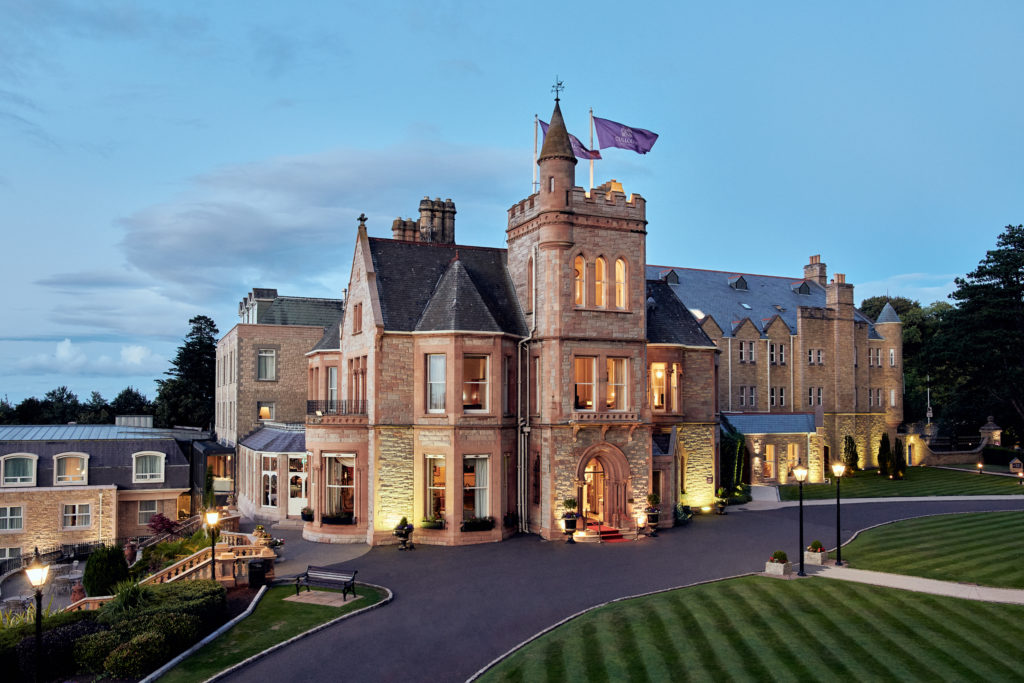 The Culloden Estate and Spa, Cultra, Co. Down (image Tourism Ireland)
The Culloden Estate and Spa, Cultra, Co. Down (image Tourism Ireland)THE Columbanus Community Folk Festival in Bangor takes place June 9-16 with a stellar cast featuring The Sands Family, Celtic Soul, Brendan Monaghan and many more. The annual event is co-sponsored by the local Comhaltas association, so expect plenty of impromptu traditional music across the week.
But why Columbanus? Quite simply, he’s the local saint, and indeed known locally as Columbán.
At Bangor Abbey, Columbán studied to become a missionary. He was evidently very good at it, because he could have been patron saint of the EU. No less a figure than composer Robert Schumann said, “St. Columbanus is the patron saint of all those who seek to build a united Europe.”
If you were brought up in Co. Down, just like I was, you would know all that — no need even to consult Uncle Wikipedia
As it happens, St. Benedict, an Italian, got the job as the Vatican’s main Europhile, and we were denied the pleasure of having our very own St. Euro’s day. In view of Brexit, maybe just as well.
Of course, any time is a good time to visit north Down, not just when there’s a folk festival on.
So, with plenty of ado, here’s pretty much the definitive guide to the area.
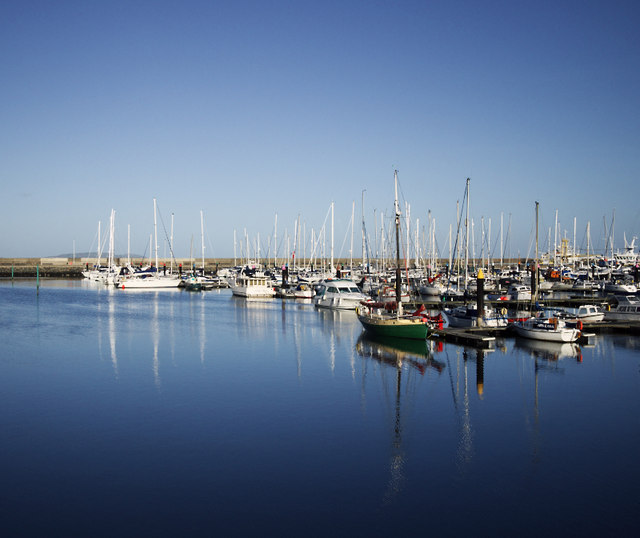 Bangor Marina (Geograph.org.uk on Wikimedia)
Bangor Marina (Geograph.org.uk on Wikimedia)Bangor
Bangor Abbey was founded by Saint Comgall around 555AD. The town of St Gallen in Switzerland is named after St Gallus who was from the monastery and, according to the Annals of Ulster, was a pupil of Comgall. And the Annals always give it to you straight.
In more recent times, say for the last 150 years, Bangor has made been in the business of providing diversion for day-trippers, international tourists and well-heeled residents
Before that the town enjoyed a long and varied history, from the Bronze Age of early Co. Down people to the Victorian pleasure seekers who travelled on the new railway from Belfast to take the sea air.
The victim of violent Viking raids in the 8th and 9th centuries, the Norse men sacked, pillaged and killed. And when they tired of killing the locals, they began to kill each other. Their rule eventually disintegrated, but further shocks were in store for Bangor in Ireland’s turbulent history.
But through strife and conflict, the town’s situation on Belfast Lough and its proximity to the city, always made it a desirable destination.
In 1858 Charles Dickens took time off from a lecture tour of Ireland to have a swim at Ballyholme Beach – a particularly attractive part of the coastline. The author was reported to have been ‘mightily impressed’ – but then we don’t know how great his expectations were.
Aside from several miles of beautiful strand, multiple top-grade restaurants and a handful of cosy pubs, the town also boasts a wide range of organised aquatic activities.
Several sailing clubs, such as SailSchoolNI (sailschoolni.com/) provide daily courses and weekend courses. You'll learn the principles of sailing — like why a yacht can sail into the wind when it patently shouldn't be able to; you'll also learn about navigation and safety at sea.
If you've never tried sailing, have a go. Leaning out of the boat in an attempt to keep your craft on an even keel, one hand on the mast shroud, the other hanging on to the jib sheet, with your head nearly touching the water: this is quite simply one of the craziest yet exhilarating modes of transport. You'll learn how to tack into the wind, go about and run safely before the wind, all in a little 14-foot boat. Just about the greatest pastime ever invented.
If you're feeling more intrepid you could try scuba diving. DV Diving (www.dvdiving.co.uk/) offers package holidays and diving opportunities for all levels of accomplishment.
Now, there are many misconceptions about scuba diving, or Self-Contained Underwater Breathing Apparatus to give its full de-acronymised name. Firstly, you do not need to be an Olympic swimmer. A reasonable proficiency is required, but that’s about it. Neither do you need to be an intrepid explorer. All dives are fully supervised, and equipment is now totally foolproof, designed to withstand even the most devious fool (I can testify to that). Into the bargain the waters round Ireland are clear — an important safety consideration — and they’re not populated by killer sharks or venomous stingrays. Watch Jaws with impunity.
To begin with, you won’t be going on any Jacques Cousteau style expeditions. Nonetheless, the Irish Sea coast offers the some very worthwhile diving, with clear waters and a remarkable diversity of underwater flora and fauna.
Oh, and the great thing about underwater sports, particularly relevant to Ireland — it doesn’t matter if it rains or not.
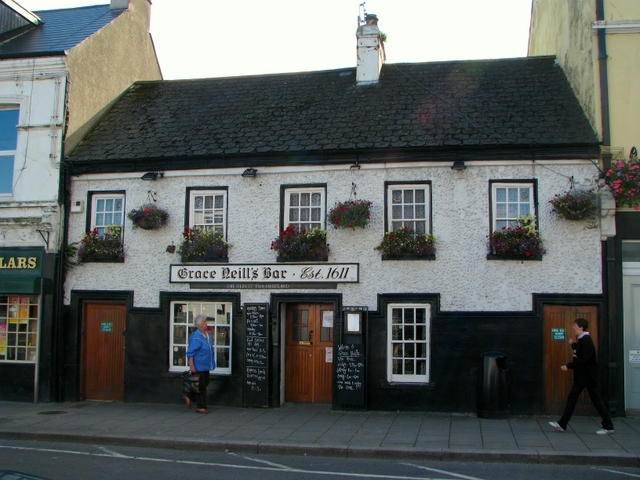 A WELCOME SIGHT Grace Neill's Bar, Donaghadee (image by Ross on Wikimedia Commons)
A WELCOME SIGHT Grace Neill's Bar, Donaghadee (image by Ross on Wikimedia Commons)Donaghadee
For the best part of three hundred years Donaghadee was only one of the most important ports in Ireland. The number one embarkation point for those heading to Britain from the north.
It boasted the shortest possible sea journey to Scotland, specificially Portpatrick, some 21 miles away. Even well into the 1900s you could get a local fisherman to row you over to Britain for a fiver.
Not anymore. The commercial days are gone. The ferries on the Larne-Stranraer, Belfast to Heysham, and Belfast Cairnryan routes superseded Donaghadee boatmen. These in turn were offered stiff competition from Belfast International and Belfast City Airport.
And so Donaghadee slipped back to what it was best at doing — being a charming, quiet seaside town, a good centre for exploring the superb beaches, and a great place to have a pint.
There is, of course, the famous Donaghadee Lifeboat, which in the past has given assistance to everyone from Spanish fisherman to English yachtsmen. To see who has been rescued lately, check on the chalkboard at the RNLI HQ just at the entrance to the harbour. While you're at the harbour, you might as well have a good look at the lighthouse, the work of Sir John Rennie and David Logan (of Eddystone fame).
The famous Grace Neill's Inn stands on High Street. There's a persistent claim that Peter the Great stayed here during his tour of Ireland, a visit undertaken to learn and take back the secrets of ship-building and linen-making to Russia. Oh alright then, if you must — the Czar of the County Down, as he was known locally.
Other celebrities known to have visited Donaghadee include Keats, Daniel Defoe, Franz Liszt (without Brahms) and Wordsworth.
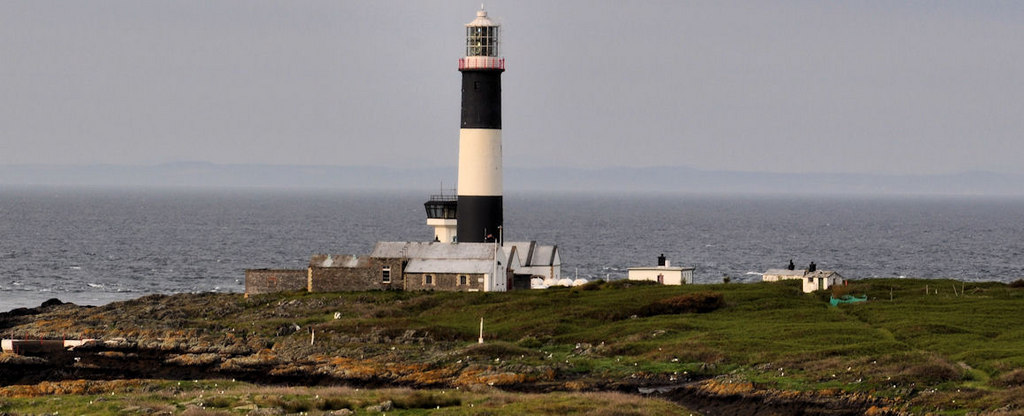 BEAM ME UP: Mew Island Lighthouse, Copeland Islands (image by Albert Bridge on Wikimedia Commons)
BEAM ME UP: Mew Island Lighthouse, Copeland Islands (image by Albert Bridge on Wikimedia Commons)The Copeland Islands
There's another marine treat, maybe not quite as exciting as scuba diving, but available at Donaghadee harbour. Little cruise boats bob their way across to the Copeland Islands, which lie just off the coast. These tiny islands, just about big enough to give you a half hour stroll, are a birdwatcher's paradise. Of an average day you'll see gannets dive-bombing into the sea, platoons of eider duck patrolling the rocks, industrious turnstones doing exactly what they should, i.e., turning stones to find tasty morsels of food, and cormorants, those half comical half sinister birds, drying out their wings. The voyage, is about half an hour— but I have to warn you — on those small craft you can feel every wave. The day I went a couple of Ulster breakfasts turned up rather unexpectedly.
Crawfordsburn
The Old Inn in Crawfordsburn has over 400 years of serving the thirsty people of this corner of Ireland behind it.
Records show this building to have been standing in its present form since 1614. The mail coach made connections with the sailing packet in Donaghadee, changing horses at The Old Inn at Crawfordsburn. So it came to be patronised by many notable people including Swift, Tennyson, Thackeray and Trollope. Local writer C. S. Lewis also popped in from time to time, his head full of nonsense about wardrobes and the like.
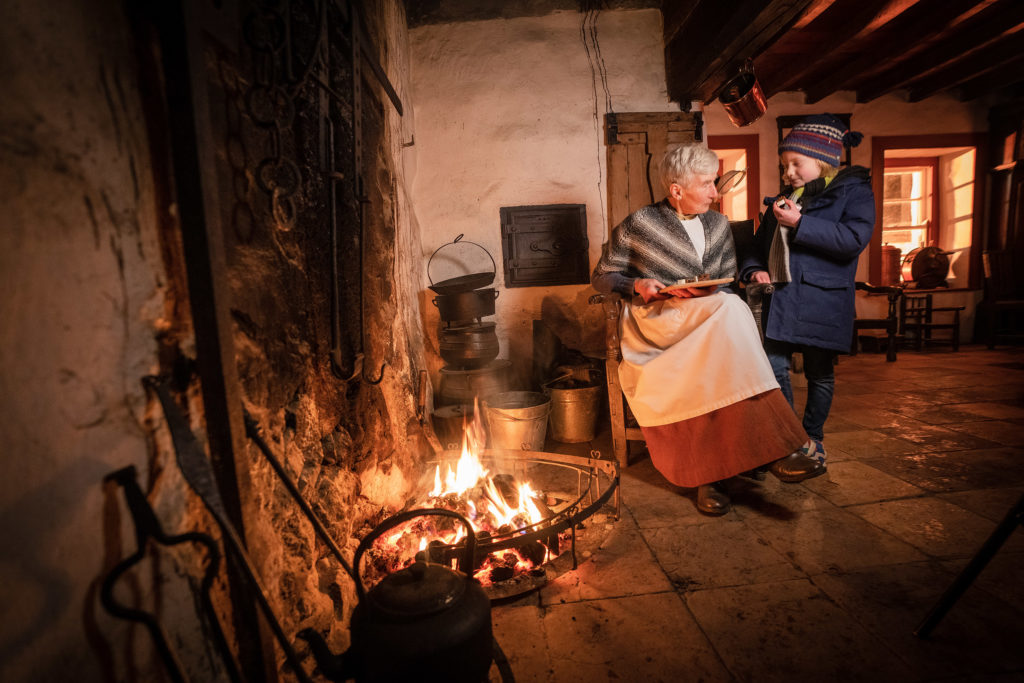 Ulster Folk Museum, Cultra, Co. Down (image Tourism Ireland)
Ulster Folk Museum, Cultra, Co. Down (image Tourism Ireland)Holywood
Famous for being the birthplace of Rory McIlroy, Holywood is also home to the exemplary Ulster Folk and Transport Museum, situated on the road from Belfast to Bangor. This, I would have to tell you, is probably just about the ugliest road in Ireland, passing through, as it does, endless roundabouts, supermarket generica, commercial warehousing and the British army’s Palace Barracks. But in a roll of hills in Cultra just above Belfast Lough is an evocative slice of Old Ireland. Farmland is tilled and livestock reared using the methods of a bygone age. Crofters’ cottages and small rural industries are a feature of the landscape, all meticulously re-created from authentic Ulster buildings.
The transport galleries hold a wonderful key for nostalgia fans. Trolley buses from Belfast, commuter trains from the old York Street Station — in the days before travellers were called commuters — compete for space with penny farthing bicycles, bone-jarring 1950s motor-cycles, trams, buses, fire-engines, aircraft and vintage cars. There's even a gull-winged DeLorean car, the ill-fated sports model made in the North by one of America's more flamboyant characters, John Zachary DeLorean.
Needless to say, no transport museum in Belfast would be complete without some mention of the Titanic. The exhibition tells the whole story of the ship from her construction, loss, and subsequent legend, to the discovery of her rusted, empty hull on the Atlantic seabed in 1985.
Groomsport
The name of Groomsport in the original Irish was Port an Ghiolla Ghruama – ‘The Harbour of the Gloomy Individual’. Who he, or she, was has been lost in the mists of history. Certainly, it long predates the landing of the Duke of Schomberg in 1689 with 10,000 troops. A monument commemorates the event.
Groomsport was already going strong by then, a fishing and trading harbour.
Today the village is a genteel, sheltered seashore village, situated just east of Bangor, with promenade, pretty harbour, cafes, shops selling all kinds of beach paraphernalia; they’ve thought of everything.
The Cockle Row Cottages – originally fishermen’s cottages – help to preserve the old world atmosphere of the village, and are now open to the public. They illustrate life for a fisherman and his family at the turn of the last century.
Where to stay
If you really want to push the boat out, as it were, The Cullloden Hotel and Spa on the shores of the lough is the number one destination.
The Culloden, is a former bishop's palace, now with a conservatory extension housing the Elysian Spa.
Gym, swimming pool, jacuzzi and steam room are set in undulating parkland overlooking Belfast Lough.
In days gone by the idea of pampering in an Irish hotel might mean you’d get an extra rasher of bacon with your breakfast — if you were lucky. Nowadays, pampering means you can demand massage oils made from the finest Irish moss, sprinkled with unguents from the Far East, and applied to your body in rooms which are filled with the scent of amontillado incense.
The Culloden has the lot, plus a cocktail bar with some very fine live jazz music. This is luxury on the lough — rooms (for 2) around the £250 mark
With thanks to

